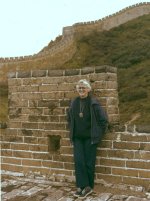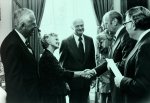
An Institute for Science and Orthomolecular Medicine, Part 1 (1973-1977)
1973
Arthur B. Robinson is asked, effective February 1, to serve as Assistant Director of Research for the Orthomolecular Medicine Laboratory. Pauling is the Director of the Laboratory of Orthomolecular Medicine.
Pauling and David Hawkins edit Orthomolecular Psychiatry: Treatment of Schizophrenia. Pauling’s contributions constitute three chapters of the book, which is published by Freeman.
The paper by Cameron and Pauling on ascorbic acid and the glycosaminoglycans is published in Oncology.
The Institute of Orthomolecular Medicine is founded as a nonprofit California corporation to engage in research in the sciences of biology and medicine. The incorporators are Pauling, Robinson, and Keene Dimick (a biochemist who has been paying the rent for the new quarters). The Articles of Incorporation of The Institute of Orthomolecular Medicine are dated May 15, 1973. In August, the Institute is classified by the Internal Revenue Service as a Public Foundation. The first research programs of the Institute represent a continuation of work that had been carried on by Pauling and Robinson at Stanford University.
On August 6 and 7, Pauling speaks at a symposium, which he has helped organize, on vitamin C and the common cold. The symposium takes place at Stanford University.
In the fall, Linus and Ava Helen Pauling travel to the People’s Republic of China.
In November, Pauling is the first Linus Pauling Lecturer in Molecular Biology and Molecular Pharmacology at Stanford University.
1974
The Institute opens a small outpatient clinic under the direction of John F. Catchpool, a doctor Pauling had met on his African trip to Albert Schweitzer’s hospital (for financial reasons, the clinic is closed in 1975).
At its meeting on July 26, the Board of Trustees of the Institute of Orthomolecular Medicine changes the Institute’s name to the Linus Pauling Institute of Science and Medicine. Pauling abides by this decision of the rest of the trustees.
In August, Pauling testifies before the Subcommittee on Health of the Committee on Labor and Public Welfare of the United States Senate. His testimony concerns food supplement legislation, and he advocates some controls over the sale and advertising of vitamins, but not through classifying them as drugs.
Pauling retires from Stanford University in August, though he continues to maintain a professional relationship with the school.
1975
Pauling publishes two papers on transition metals in PNAS.
Linus Pauling and Peter Pauling publish Chemistry with Freeman.
In the spring, the Linus Pauling Institute comes under severe financial duress. Salaries are cut on the basis of a sliding scale, so that the sacrifice will have minimum impact on workers with low and moderate salaries.
In the summer, Pauling becomes a Fellow of the Linus Pauling Institute, and his job as President and Director is taken over by Arthur B. Robinson.
Because of the Institute’s mounting debts, Pauling donates 50% of his salary to the Institute for the first of 1975 and 100% of his salary for the second half.
In September, President Gerald R. Ford presents Pauling with the National Medal of Science, citing the "extraordinary scope and power of...imagination" that led to his basic contributions in structural chemistry, molecular biology, immunology, and molecular medicine (the award is long overdue, since it was twice postponed by the previous Nixon Administration).
1976
On March 1, Arthur B. Robinson hires Richard Hicks to help in raising funds for the Institute.
On April 5, Pauling delivers the Centennial Address of the American Chemical Society in New York City. He speaks on "What Can We Expect for Chemistry in the Next 100 Years?"
During the summer, Ava Helen Pauling experiences troubles with her digestion, and a physician discovers that she has a large tumor in her stomach. She has a three-quarter gastrectomy and recovers well from the surgery.
Pauling publishes Vitamin C, the Common Cold, and the Flu, an updated version of his earlier book.
Ewan Cameron and Pauling publish "Supplemental Ascorbate in the Supportive Treatment of Cancer: Prolongation of Survival Times in Terminal Human Cancer." In this paper they report the results of a clinical trial in which a hundred terminal cancer patients were given supplemental ascorbate as part of routine management, leading to much longer survival times than would be expected from patients with similar cancers.
1977
In February, Dr. Emile Zuckerkandl joins the staff of the Linus Pauling Institute. Born in Austria and raised in France, Dr. Zuckerkandl had previously collaborated with Pauling on molecular evolution. He plans to work in genetics at the Institute.
Governor Bob Straub of Oregon declares June 1 "Linus Pauling Day" in Oregon. This is the day that the Public Broadcasting System televises the NOVA series documentary "Linus Pauling, Crusading Scientist," which had been produced by Robert Richter.
Pauling has 600 mice developing cancer at the Institute. He and his associates are checking to see what effect different nutrients have on the rate of tumor growth.
During the summer, Pauling travels to Iceland, where he is honorary president of a conference on the Environment and the Future of Man. He and Ava Helen then go to a meeting of Nobel laureates in chemistry in Switzerland. He also lectures in Munich, where he and his wife celebrate the 50th anniversary of their stay there when he was just getting started as a scientist.
Table of Contents
- The Ancestry of Linus Pauling (The Paulings)
- The Ancestry of Linus Pauling (The Darlings)
- Linus Pauling's Childhood (1901-1910)
- Linus Pauling's Adolescence (1910-1917)
- Pauling's Years as an Undergraduate at Oregon Agricultural College, Part 1 (1917-1919)
- Pauling's Years as an Undergraduate at Oregon Agricultural College, Part 2 (1919-1922)
- Linus Pauling as a Graduate and Postdoctoral Student at the California Institute of Technology, Part 1 (1922-1923)
- Linus Pauling as a Graduate and Postdoctoral Student at the California Institute of Technology, Part 2 (1924-1926)
- A Guggenheim Fellow in Europe during the Golden Years of Physics (1926-1927)
- Early Career at the California Institute of Technology (1927-1930)
- Pauling's Great Years of Achievement in Structural Chemistry, Part 1 (1931-1932)
- Pauling's Great Years of Achievement in Structural Chemistry, Part 2 (1933-1935)
- Pauling's Increasing Involvement in Molecular Biology (1936-1939)
- The War Years, Part 1 (1940-1942)
- The War Years, Part 2 (1943-1945)
- The Postwar Years, Part 1 (1946-1947)
- The Postwar Years, Part 2 (1948-1949)
- Proteins, Passports, and the Prize (1950-1954)
- Increasing Involvement in World Peace, Part 1 (1955-1958)
- Increasing Involvement in World Peace, Part 2 (1959-1963)
- The Center for the Study of Democratic Institutions (1964-1967)
- The University of California, San Diego (1968-1969)
- Stanford University (1969-1972)
- An Institute for Science and Orthomolecular Medicine, Part 1 (1973-1977)
- An Institute for Science and Orthomolecular Medicine, Part 2 (1978-1981)
- The Years Alone: Pauling after the Death of Ava Helen, Part 1 (1982-1988)
- The Years Alone: Pauling after the Death of Ava Helen, Part 2 (1989-1994)
- About the Author




